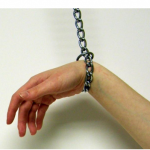By Askouni Ioanna, Zirou Dionysia & Erda Eleni
Mental health conditions affect millions of people in every part of our planet. In fact, according to research conducted by the World Health Organization, one in four people worldwide suffer from a mental disorder. Over the last year, mental disorders are the second most common illnesses after the heart diseases. Here are some of the strangest mental disorders out there:
STENDHAL SYNDROME
Those with Stendhal syndrome experience physical and emotional anxiety as well as panic attacks, dissociative experiences, confusion and hallucinations when exposed to art. These symptoms are usually triggered when the individual is exposed to large quantities of art that are concentrated in a single place, such as a museum or gallery. However, individuals may experience similar reactions to beauty in nature. This syndrome is named after a 19th century French author who experienced the symptoms during a trip to Florence in 1817. Stendhal syndrome may also be called hyperculturemia or Florence syndrome. It has been described by Italian psychiatrist Graziella Magherini who observed over a hundred similar cases among tourists in Florence, who suffered a heart attack while admiring artworks and phenomena of great beauty.
Patient’s experience
“I was in a sort of ecstasy, from the idea of being in Florence, close to the great men whose tombs I had seen. Absorbed in the contemplation of sublime beauty … I reached the point where one encounters celestial sensations … Everything spoke so vividly to my soul. Ah, if I could only forget. I had palpitations of the heart, what in Berlin they call “nerves’. Life was drained from me. I walked with the fear of falling…”
CAPGRAS DELUSION
Capgras delusion is a psychiatric disorder in which a person holds a delusion that a friend, spouse, parent, or other close family member (or pet) has been replaced by an identical impostor. It is named after Joseph Capgras (1873–1950), a French psychiatrist. The delusion most commonly occurs in individuals diagnosed with paranoid schizophrenia but has also been seen in brain injury, dementia with Lewy bodies and other dementia. It presents often in individuals with a neurodegenerative disease, particularly at an older age. It has also been reported as occurring in association with diabetes, hypothyroidism, and migraine attacks. In one isolated case, the Capgras delusion was temporarily induced in a healthy subject by the drug ketamine. It occurs more frequently in females, with a female to male ratio of approximately 3 to 2. It is generally agreed that the Capgras delusion has a complex and organic basis (caused by structural damage to organs) and can be better understood by examining neuroanatomical damage associated with the syndrome.
Patient’s experience
Diane was a 28-year-old single woman who was seen for an evaluation at a day hospital program in preparation for discharge from a psychiatric hospital. This was her third psychiatric admission in the past five years. Always shy and reclusive, Diane first became psychotic at age 23. Following an examination by her physician, she began to worry that the doctor had damaged her internally and that she might never be able to become pregnant. The patient’s condition improved with neuroleptic treatment but deteriorated after discharge because she refused medication. When she was admitted eight months later, she presented with delusions that a man was making exact copies of people—»screens». The diagnosis was schizophrenia with Capgras delusion. She was disheveled and had a bald spot on her scalp from self-mutilation. - Sinkman, 2008
THE ALIEN HAND SYNDROME
Aien hand syndrome is a phenomenon in which one hand is not under control of the mind. Th e person loses control of the hand, and it acts as if it has a mind of its own. Th e etiology includes neurosurgery, tumor, aneurysms, and rarely stroke. This case is presented to create awareness of this interesting clinical scenario, which can be terrifying to the patients and confusing to the physicians who are not aware of it.
Patient’s experience
A 77-year-old woman presented with the complaint of observing her left hand moving without her knowledge while watching television. Her left hand stroked her face and hair as if somebody was controlling it. These movements lasted only half an hour but on recovery, she had left hemiparesis. Alien hand syndrome as the presentation of cardioembolic stroke is extremely rare but can be terrifying to patients.
DISSOCIATIVE IDENTITY DISORDER
Dissociative identity disorder (DID), previously known as multiple personality disorder (MPD),is a mental disorder characterized by having at least two distinct and relatively enduring personality states.The disorder is accompanied by memory gaps beyond what would be explained by ordinary forgetfulness.The personality states alternately show in a person’s behavior ;however, presentations of the disorder vary. Other conditions that often occur in people with DID include post-traumatic stress disorder, personality disorders (especially borderline and avoidant), depression, substance use disorders, conversion disorder, somatic symptom disorder, eating disorders, obsessive–compulsive disorder, and sleep disorders. Self-harm, non-epileptic seizures, flashbacks with amnesia for content of flashbacks, anxiety disorders, and suicidality are also common.
Patient” s experience
As a child, Jeni was repeatedly raped and tortured by her father, Richard Haynes, in what Australian police say is one of the worst child abuse cases in the country.To cope with the horror, her mind used an extraordinary tactic – creating new identities for her to detach from the pain. The abuse was so extreme and so persistent, she says she ultimately generated 2,500 distinct personalities to survive. And in the landmark trial in March, Jeni confronted her father to present evidence against him through her personalities, including a four-year-old girl named Symphony. We weren’t scared. We had waited such a long time to tell everyone exactly what he did to us and now he couldn’t shut us up,» she said.





